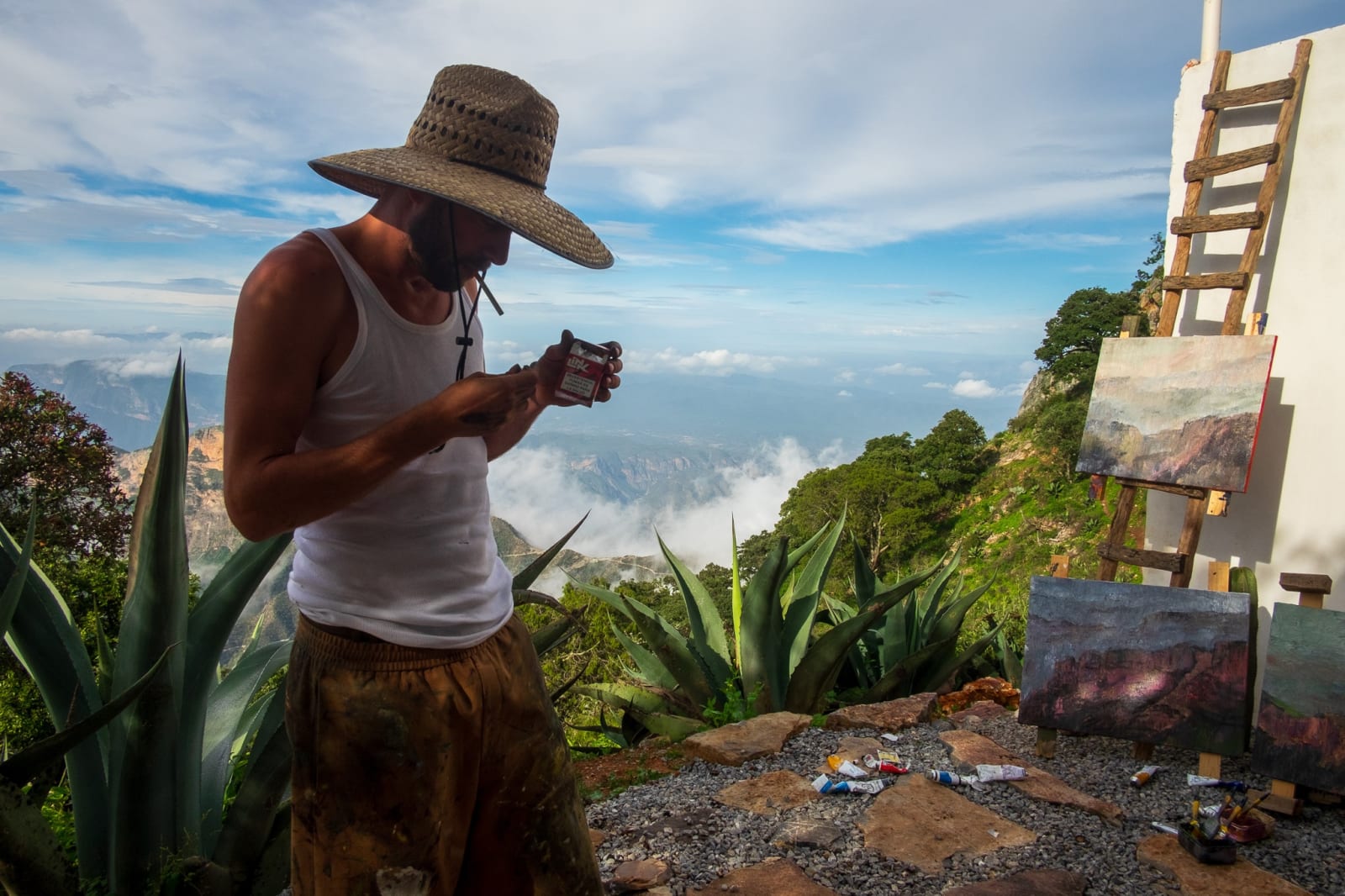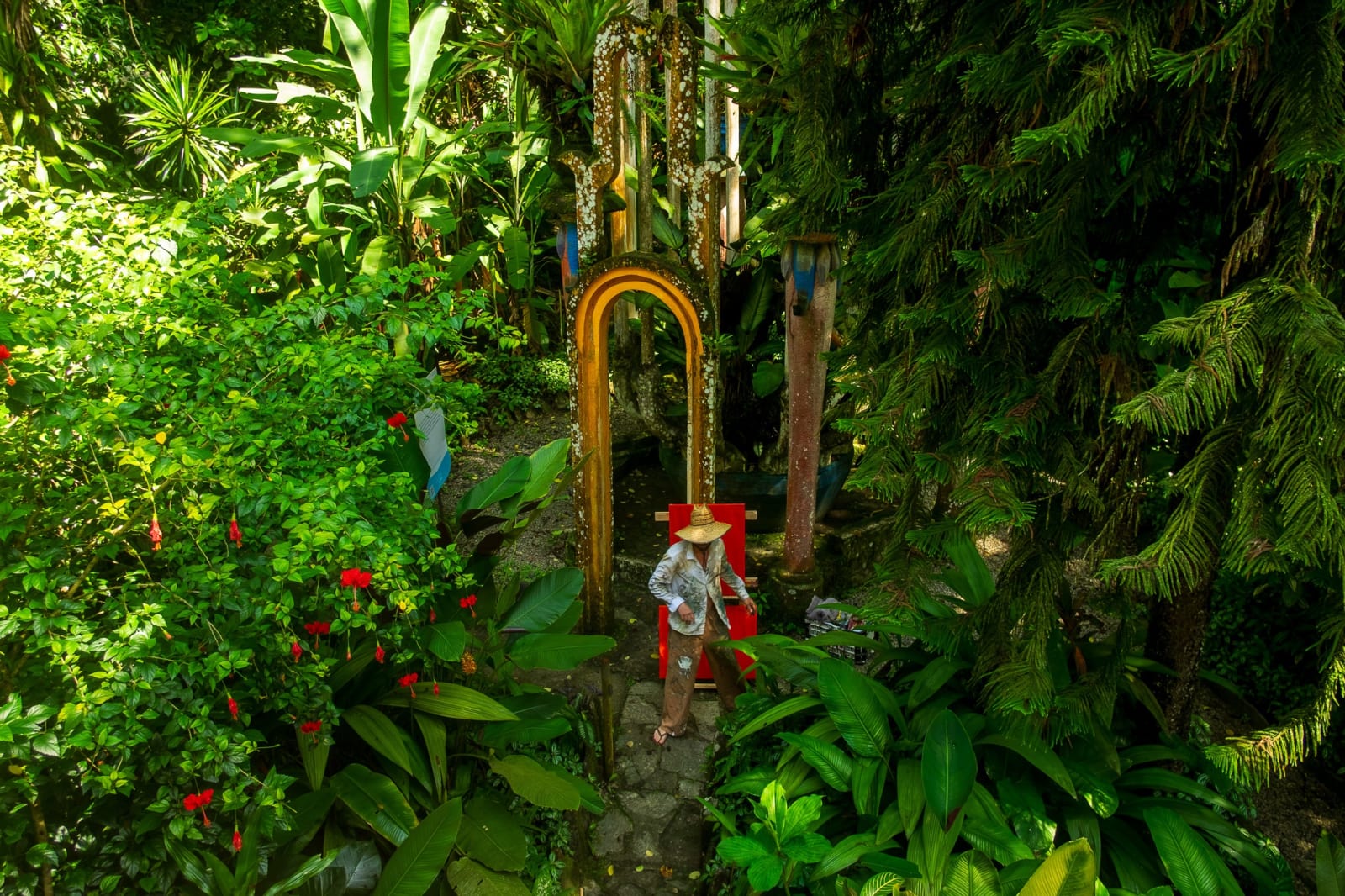BORROWED LANDSCAPE
An exhibition by Nils Verkaeren
Sponsored by the Secretaría de Cultura del Estado de Querétaro
⸻
Opening: Friday, June 6, 2025 – 20:00
Venue: Museo de la Ciudad, Guerrero #27, Centro, Querétaro, Qro.
Exhibition on view: June 6 – August 17, 2025
Admission: Free
⸻
The Secretaría de Cultura del Estado de Querétaro is proud to present Borrowed Landscape, a solo exhibition by Belgian artist Nils Verkaeren, hosted at the Museo de la Ciudad in Querétaro. Opening on Friday, June 6 at 8:00 PM, the exhibition brings together a series of plein air paintings created during the artist's travels across Mexico in the summer of 2024.
Spanning six distinct sites-from the lush surrealism of Las Pozas in Xilitla to the arid vastness of the Zapoítitán Botanical Garden-Verkaeren immersed himself in curated and wild environments, responding directly to their climates, textures, and shifting atmospheres.
His works trace a movement across gardens, deserts, and mountains, translating temporal presence into charged painterly surfaces. What binds the series is not a search for fixed representation, but a deep engagement with observation as process-each canvas a record of spatial intimacy, material response, and momentary perception.
Painted on location in places such as the Ossart & Maurières gardens in San Miguel de Allende, the Lago de Chapala garden, Cuatro Palos, and other iconic landscapes, the Borrowed Landscape series reflects Verkaeren's ongoing investigation into how painting can become an embodied act of seeing and being. These are not static depictions, but dynamic correspondences between artist and environment.
The exhibition is free and open to the public until August 17, 2025.
⸻
"THE BORROWED LANDSCAPE - NILS VERKAEREN":
The Ossart and Maurières garden in San Miguel de Allende is a glowing landscape with diverse native Mexican vegetation, dominated by towering cacti among low grasses and shrubs. The changing light from heavy clouds constantly alters the atmosphere. Nils Verkaeren started with small wooden panels for light and color studies, capturing the location's nuances before moving to large-scale works. The small paintings explore composition and mood, while the large canvases focus on the contrast between the robust cacti and the ephemeral sky. Bold, expressive brushstrokes blend with light, flowing ones, reflecting the mix of earthy tones and cool sky hues. Verkaeren's approach balances intimacy and observation with spatial grandeur, blending detail and expressiveness.
⸻
Las Pozas, located in the Xilitla jungle, is a surreal garden designed by British artist Edward James. The garden's concrete structures blend organically with the lush vegetation, creating a unique harmony between nature and architecture. Nils Verkaeren captured both the vibrant tropical plants and the monumental concrete sculptures in his paintings. The moss-covered, weathered forms seem to come alive amid the dense greenery. His expressive brushstrokes and wild contrasts emphasize the tension between the rational garden structures and the wild, untamed foliage. Verkaeren's dynamic approach merges the colors of tropical plants with the weathered tones of concrete, reflecting the surreal atmosphere where dream and reality meet.
⸻
Cuatro Palos is the only location in this project that is not a formal garden. The landscape is characterized by majestic mountains stretching to the horizon, while clouds gather in the morning and linger between the hills in the afternoon. This natural phenomenon creates a mystical atmosphere in which the sky and earth seem to merge. Nils Verkaeren approaches this site with a more subdued palette and a pure grandeur of the landscape. He paints the fleeting transitions of the massive mountains and the delicate, floating clouds that drape like blankets over the peaks. The works capture the dynamic nature of the landscape in its ephemerality, with misty veils softening the rigid outlines of the terrain. The joining of stones, plants, and sky creates a lyrical composition that evokes the transience of the moment. Verkaeren captures the poetic encounter between solid forms and moving elements, allowing the paintings to convey both strength and stillness.
⸻
The Lago di Chapala garden, designed by Ossart and Maurières, is divided into three distinct zones. The first features a humid, tropical area with towering palm trees and lush ferns. The second zone features water terraces with lilies and shallow basins. The final zone consists of dry hills and volcanic soil and is characterized by drought-resistant vegetation and cacti enduring heat and drought. Nils Verkaeren was captivated by this hybrid garden, with its three microclimates and their transitions. His paintings reflect the area's expressive shifts in form and color. His canvases depict organic growth, highlighted by deep tones, transitions between atmospheres, high-contrast colors, and transitions between gashed grounds and rugged vegetation. The result is a series of works that reflect harsh aridity, while also evoking both wild energy and steady resilience.
⸻
The Zapoítitán Botanical Garden is a vast, arid landscape dominated by towering, ancient cacti with weathered trunks and grooved skin. These resilient giants stand among rugged limestone formations and cracked earth, contrasting starkly with the bright blue sky.
The scorching heat shimmers from the ground, while the great cacti shelter beneath, sharply against the sun. The visual contrast between dry soil and vibrant plants symbolizes endurance and survival inspired by this powerful presence. Nils Verkaeren captures both the rough textures and the intense atmosphere. His expressive brushstrokes emphasize the zone between air and earth. He chooses to convey the tension of the place through bold harshness and chromatic vitality, reflecting the place's enduring spirit.
⸻
Sijil, Tulum, March 2025
In this new artistic project, Verkaeren deliberately chooses six different painting locations. This diverse series of works is inspired by each region's unique mood and atmosphere. Each painting becomes a reflection of the ephemeral beauty of the moment. He paints not to capture a scene as it appears, but to create a record of how it feels in that specific time and place.
In this way, Verkaeren explores the delicate balance between observed landscape and the artist's internal experience. He chooses gardens for their curated beauty and symbolic structure. The result is a series of works that do not attempt to capture the power of a place as a fixed state or static memory, but as a dynamic, living process of perception.
⸻
In July and August 2024, Nils Verkaeren travelled to Mexico to get inspired by and work in its landscapes. This resulted in a series of paintings called The Borrowed Landscape.
A landscape is a part of the Earth's surface that can be seen from one place at one time.
- National Geographic
"It is not my intention to interpret the work of Nils Verkaeren (Antwerp, Belgium, 1990); his pieces speak for themselves and evoke an emotion that requires no further explanation, beyond what the direct contact with them arouses. Nevertheless, I take this opportunity to offer a moment of reflection by sharing some of the context in which he develops as an artist."
- Lorenzo Álvarez
The word "landscape" comes from the Flemish term landschap, which means "painting of the countryside." Although it is now difficult to distinguish between the meaning of the word, it is important to remember that the concept was directly imported by geographers from art history and conceived by artists as an image that observes nature with all its surfaces, time, and places and returns them to the world through his pictorial action.
The same region where the word landscape finds its origins is the native land of Verkaeren, and hence the logic that "articules" his career as an artist, after having been trained at the Royal Academy of Fine Arts in Antwerp. Nils also teaches drawing and painting in that city, where he works with young minds like his landscape: inhabited and barren minds he should nourish.
Nils observes the Earth's surface and transforms it by borrowing a landscape and incorporating it into his work. This act gives his works the tone of a diary, a logbook, a witness of a place, its vegetation, weather, and orography, its light, and the moments of a season. His paintings are made by looking outwards, but also inwards: where he understands what he sees and what he is. He uses painting as a medium that allows him to observe and depict how he is affected by space and time.
Nils comfortably settles in his landscapes, braves the wind, the mosquitoes, and the temperature, and works quickly, knowing he has little time. He observes and records without planning-wherever he decides to stop, he starts to work as if he were inside himself: this is how oil and canvas become skin and bones.
This past summer, Nils explored the landscapes of Mexico. He did so directly in the valleys of a region he had never seen before. He painted in Las Pozas in Xilitla, at the surrealist garden created by Edward James; in the Ossart + Maurières garden in San Miguel de Allende (Guanajuato); at the Lago di Chapala and the Zapotitán Botanical Garden. And he painted in Cuatro Palos, in the Sierra Gorda de Querétaro, the only non-garden landscape of this project. He goes from place to place and paints, and today, for Verkaeren, his gaze has perhaps become landscape, and his landscape has become painting.
- Lorenzo Álvarez

















